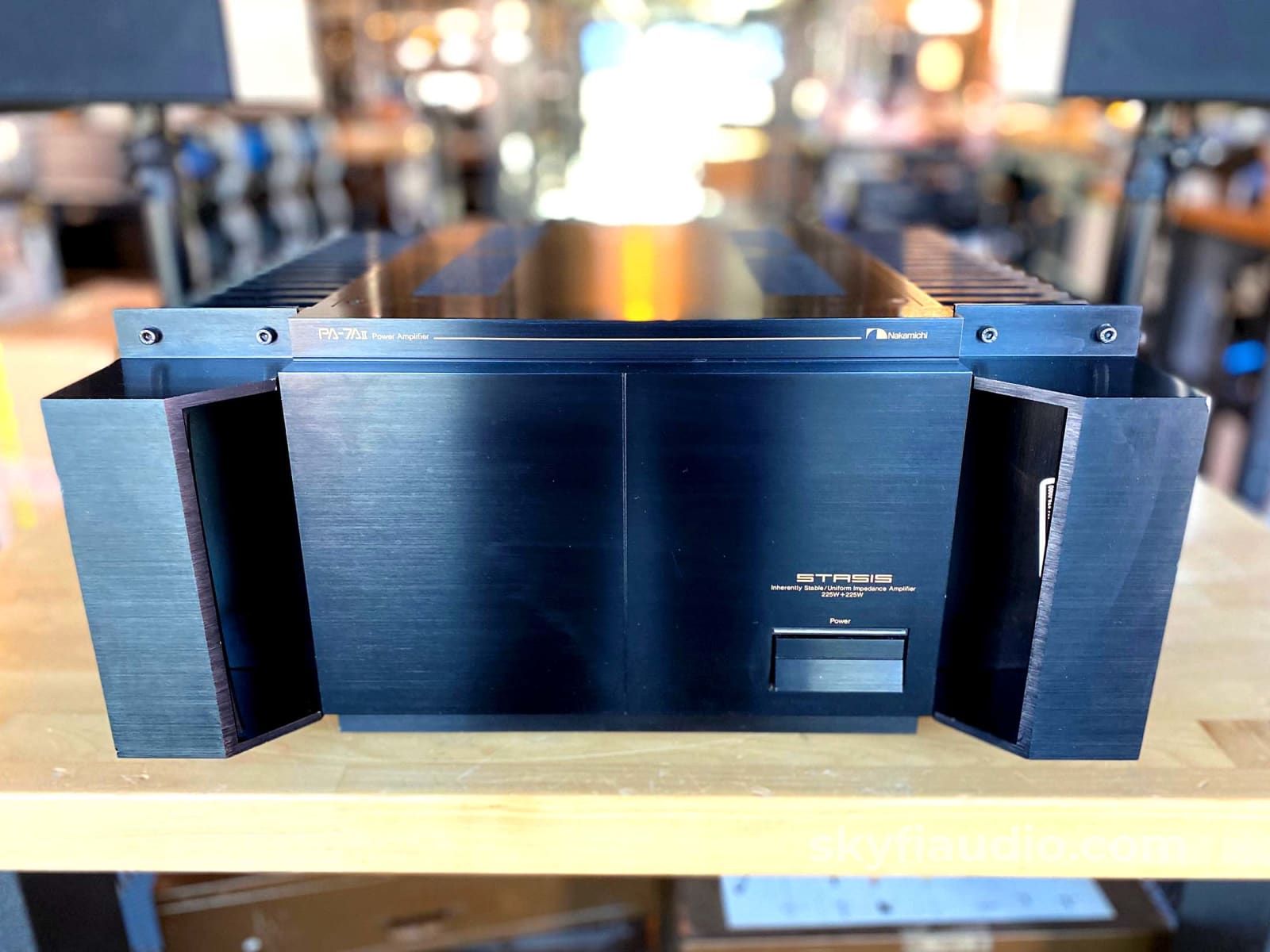
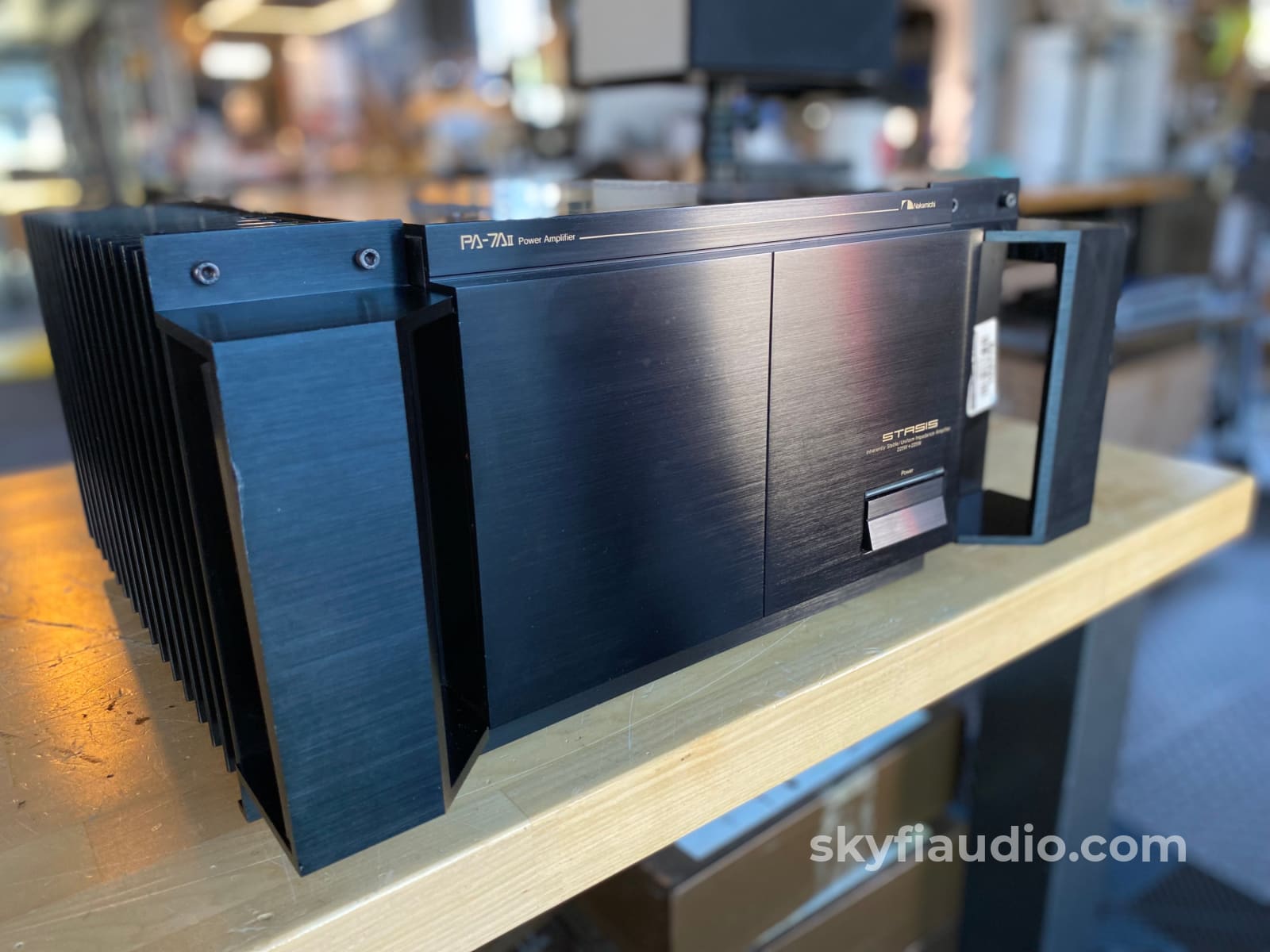
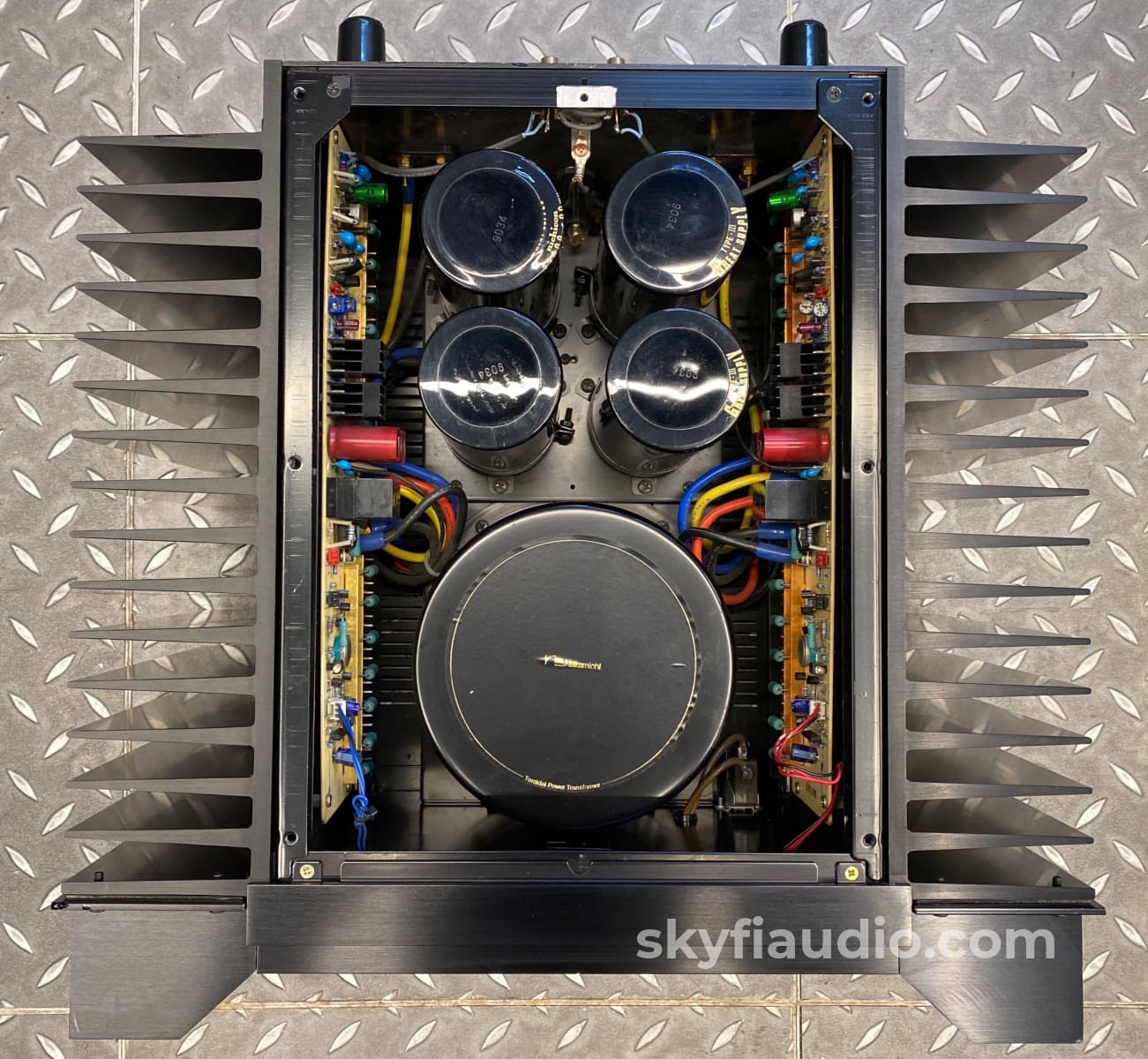
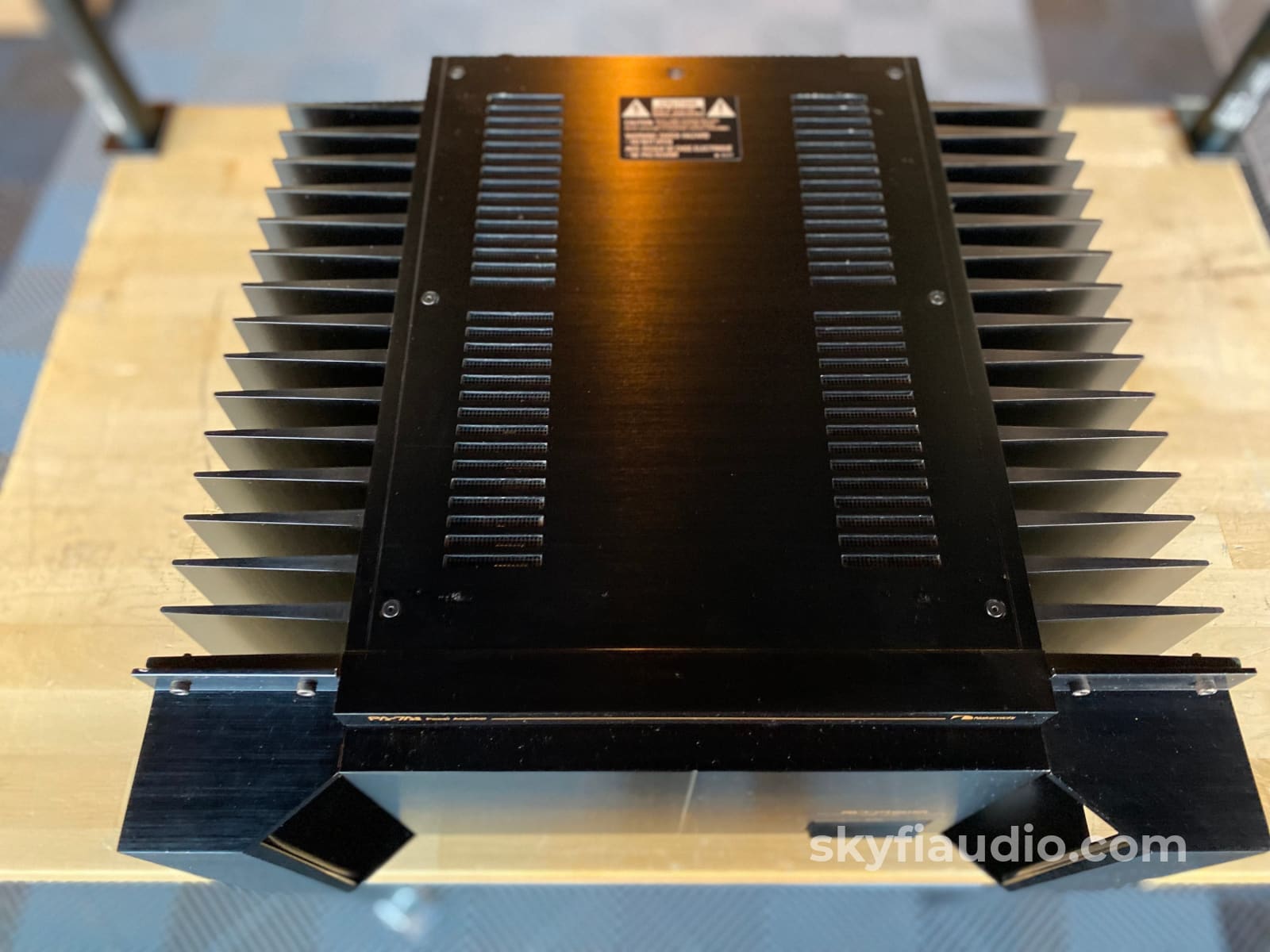

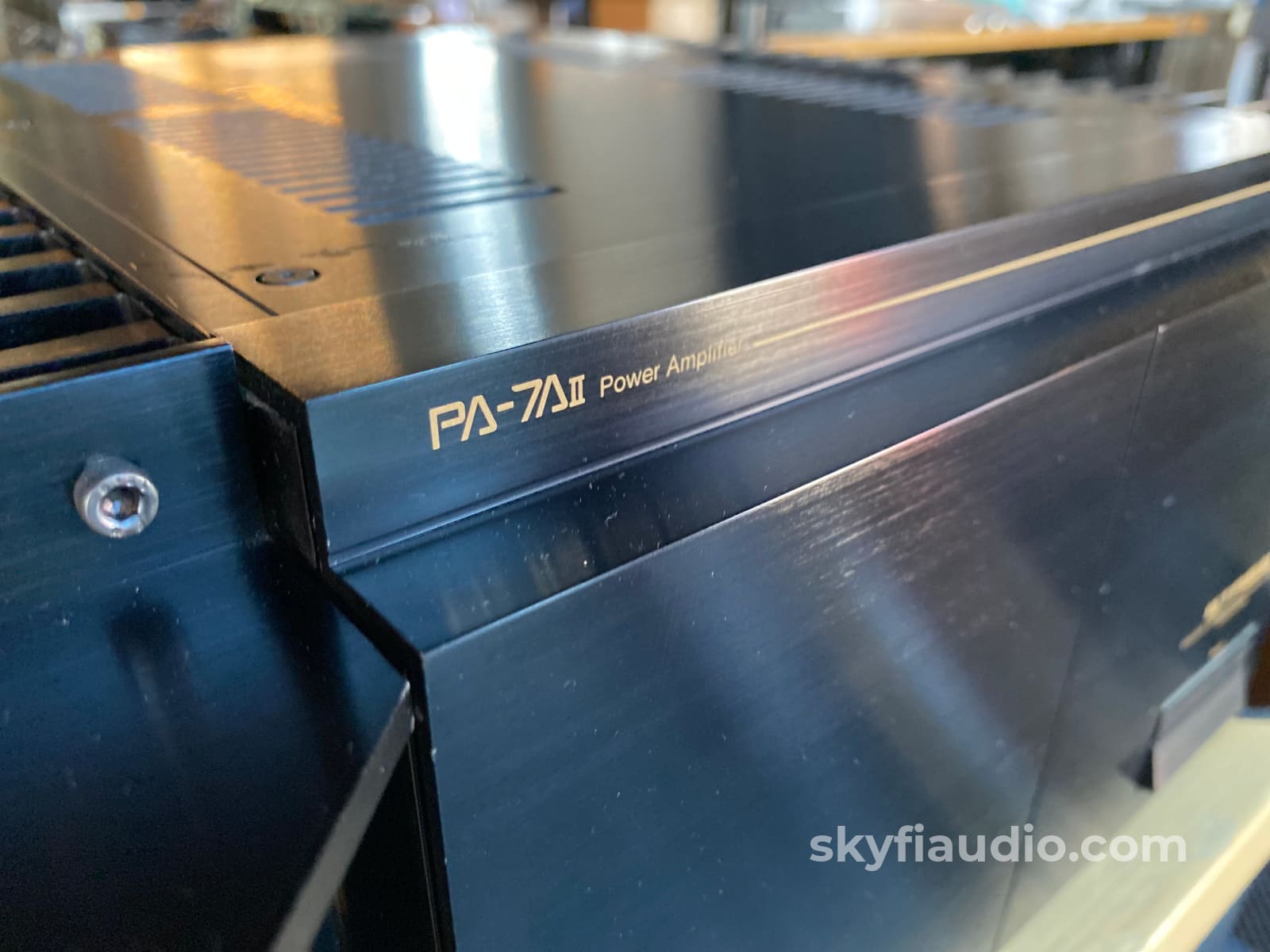
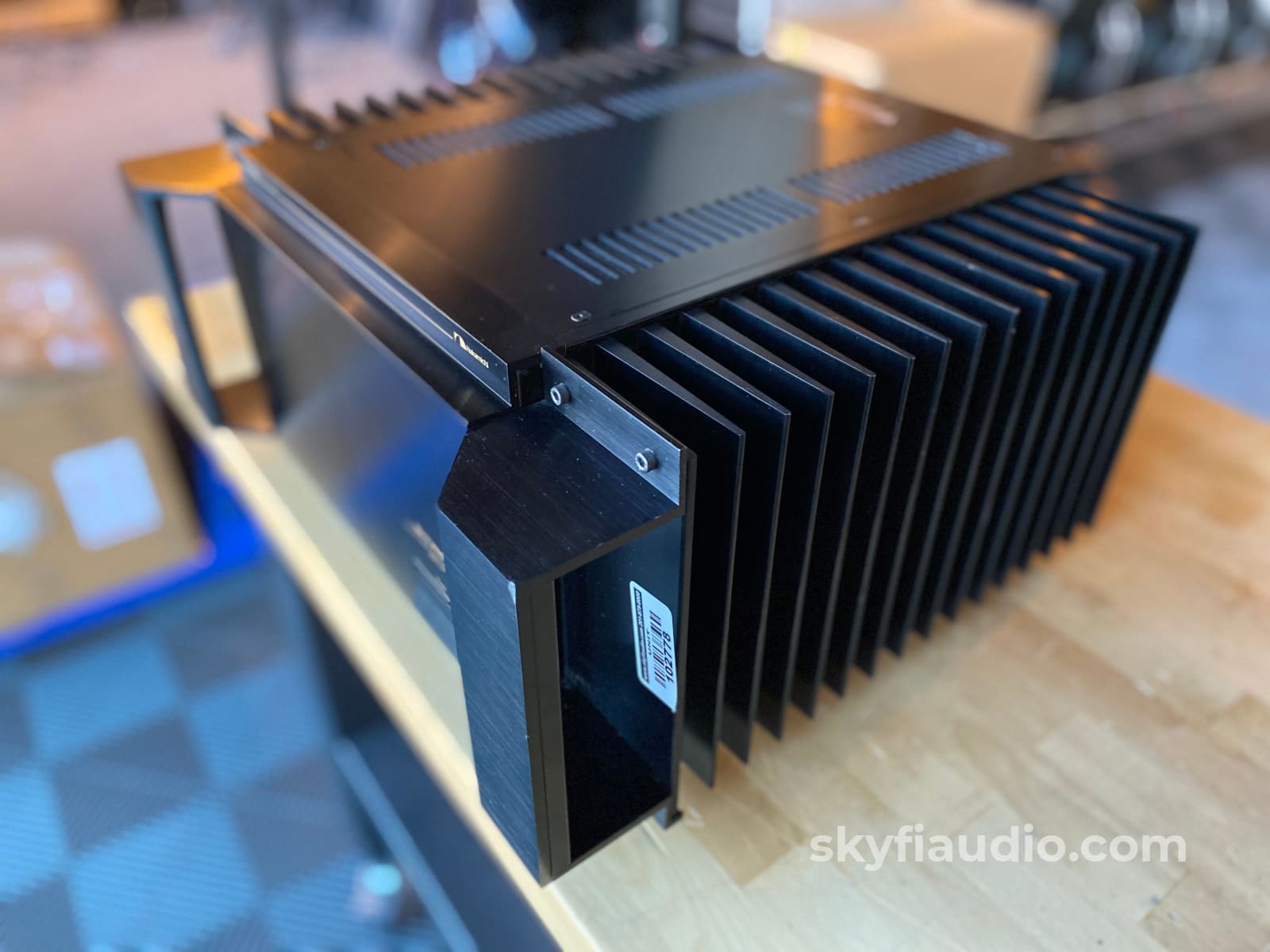
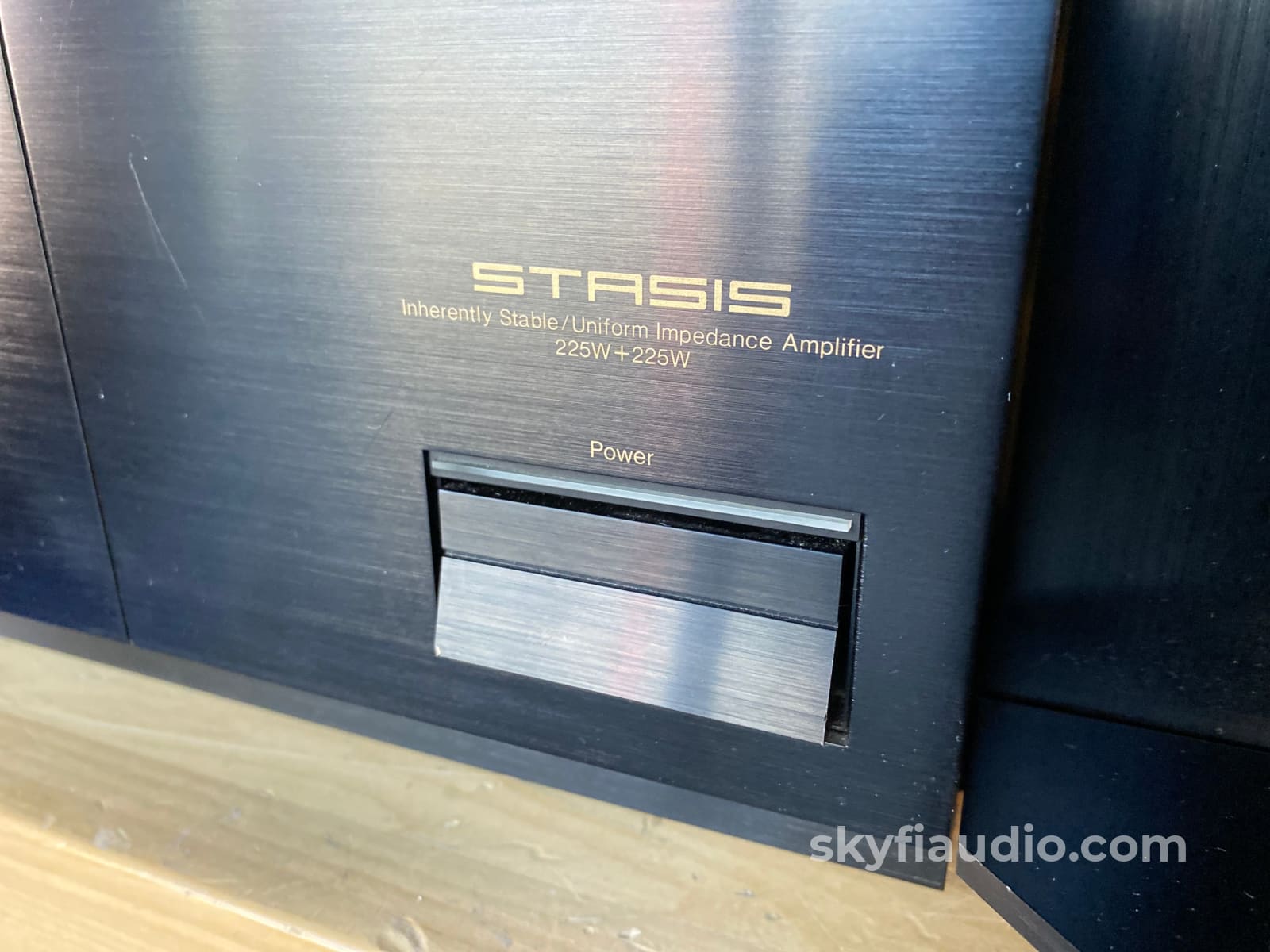
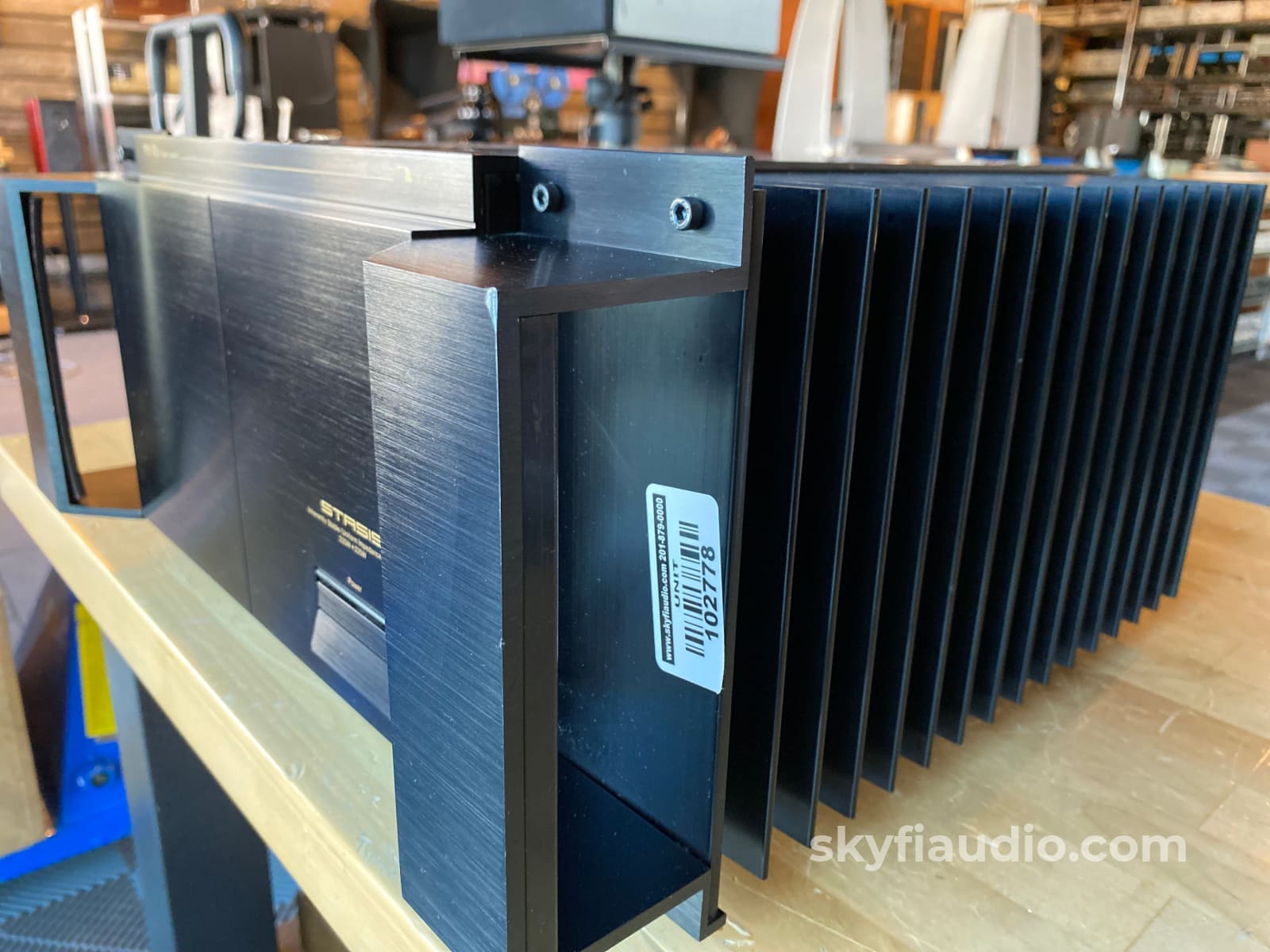
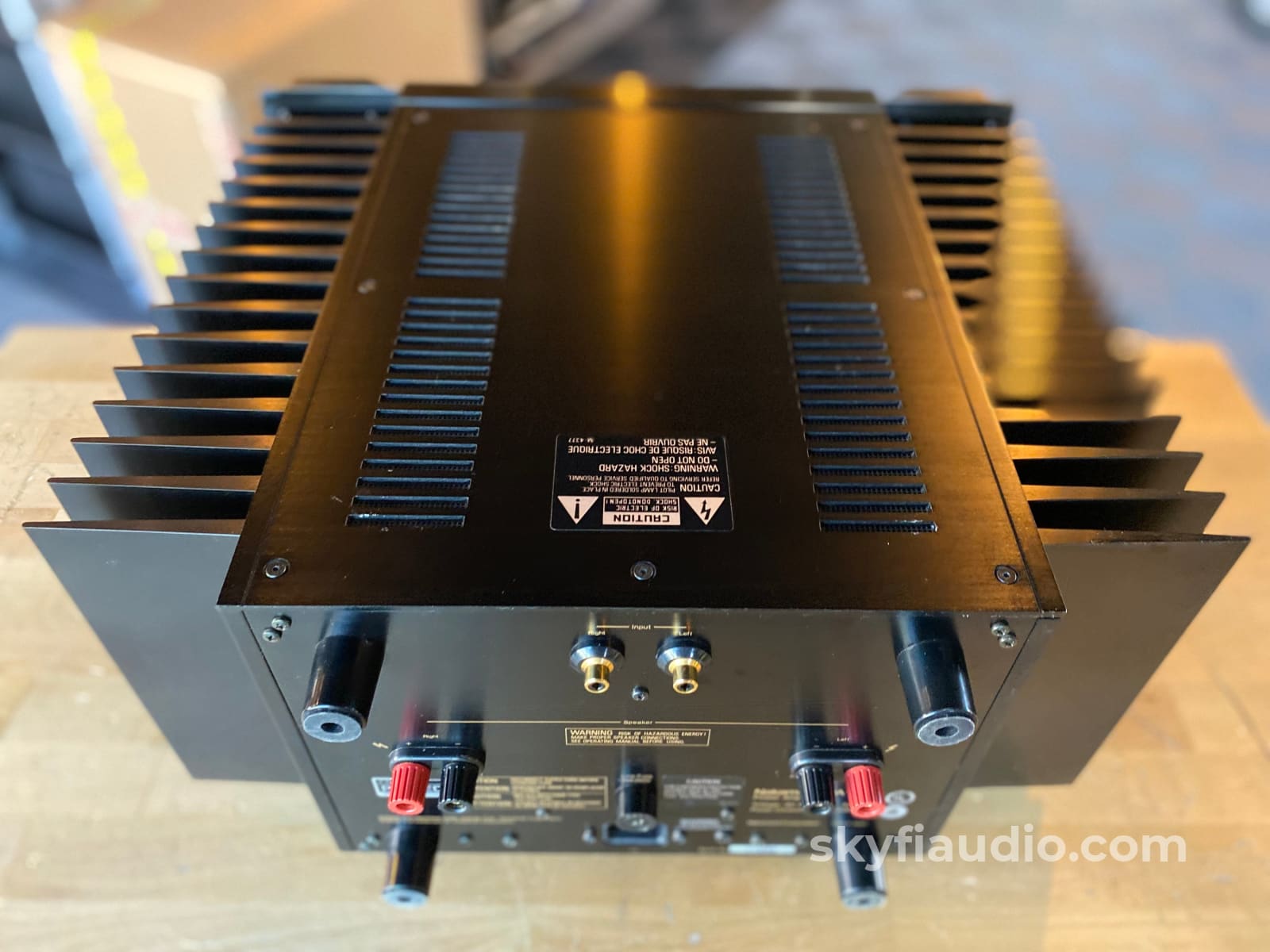
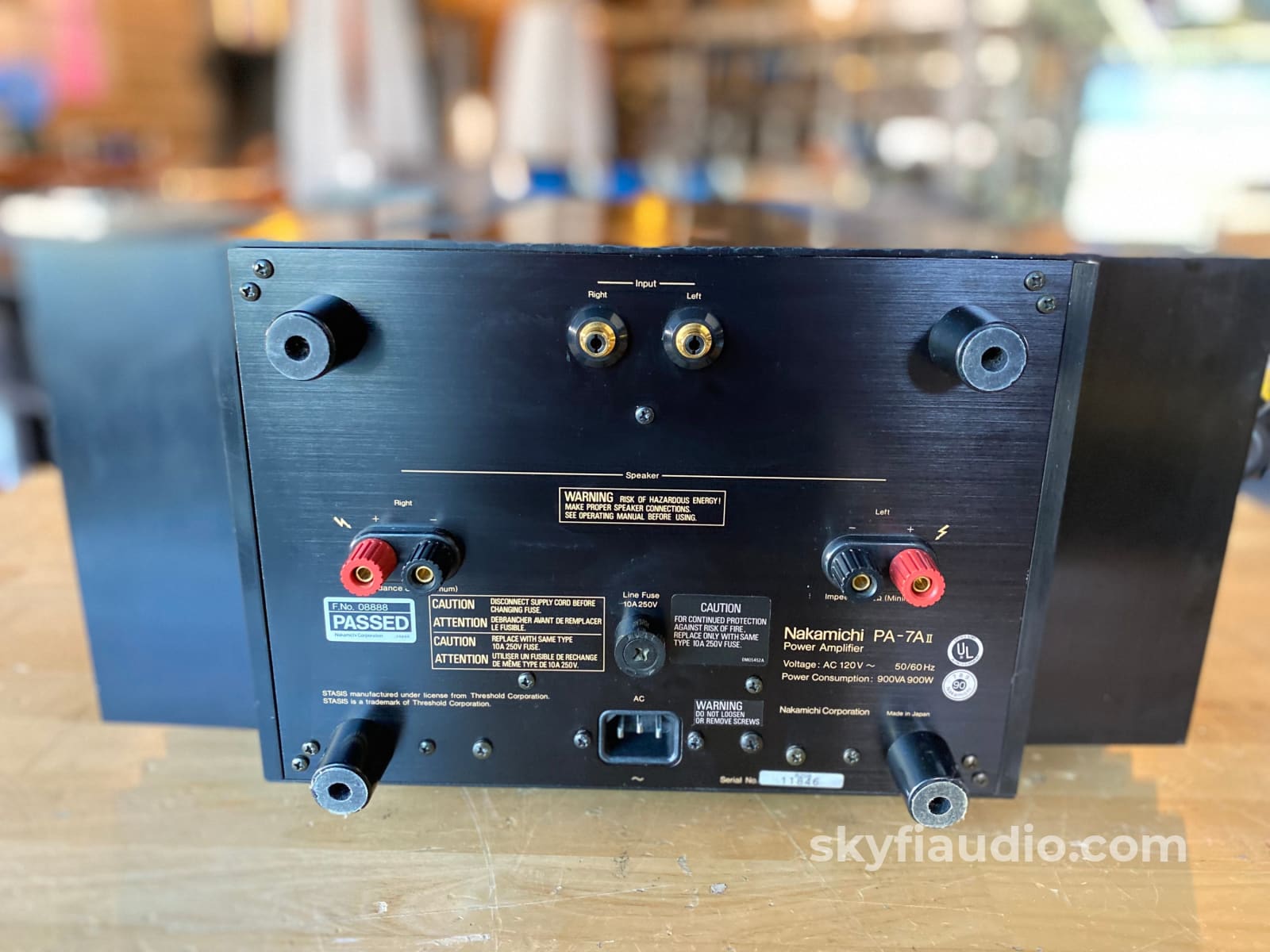
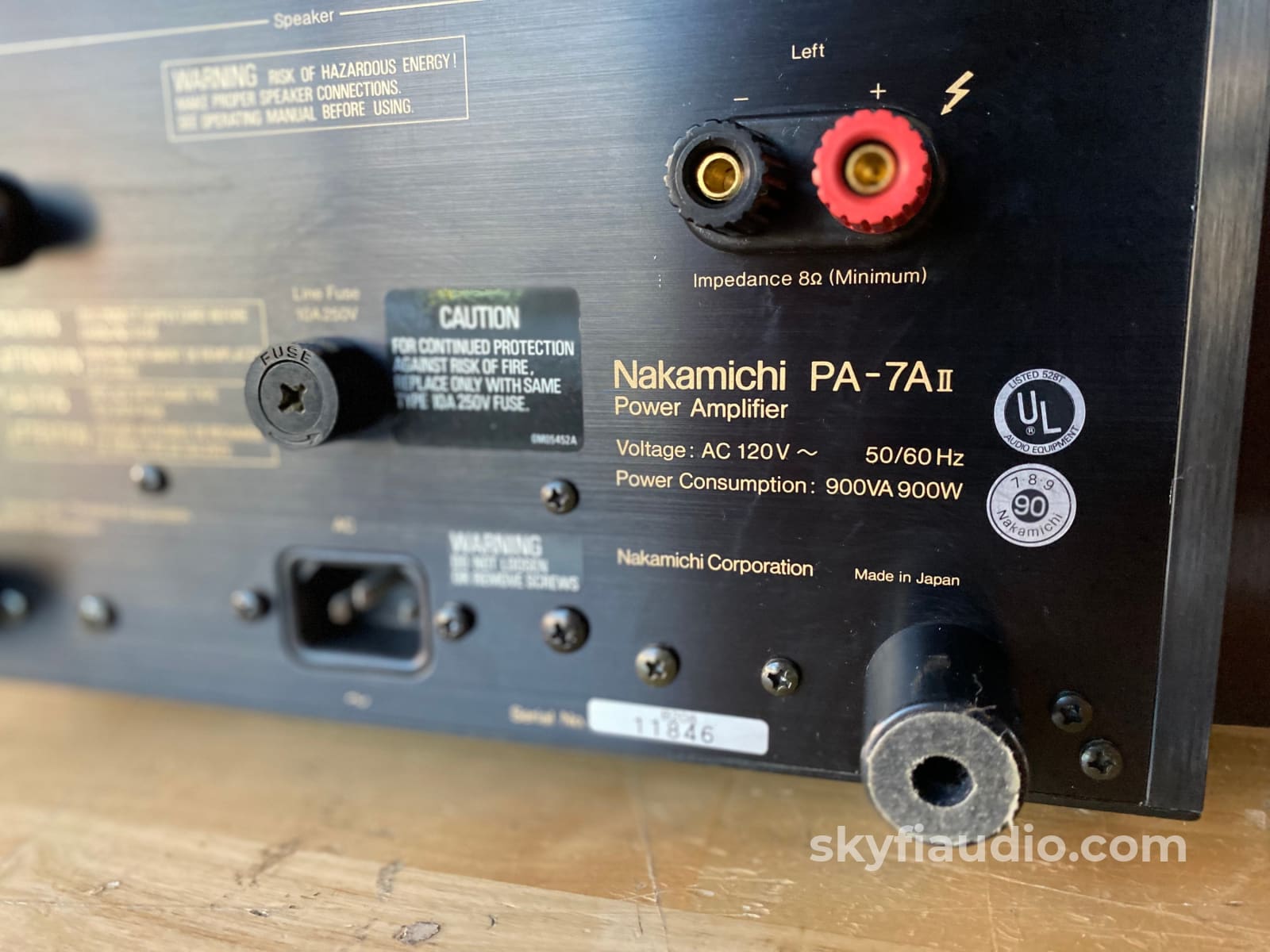
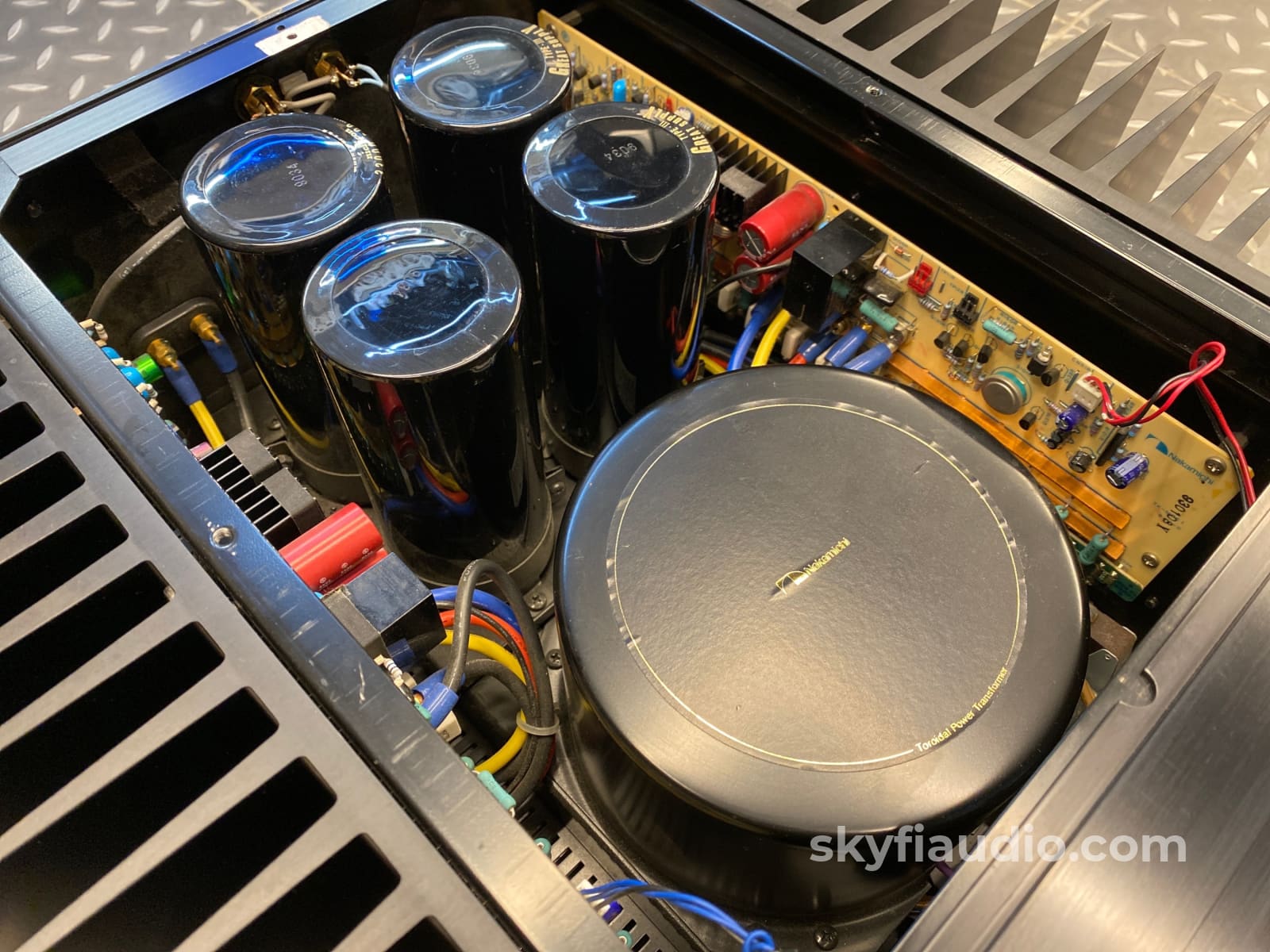
Nakamichi PA-7AII Stasis Vintage Power Amplifier With 225W x 2!
Free Shipping on Most Electronics - Excludes Speakers and Items Requiring Freight - Contiguous U.S. Only
Pickup currently unavailable at SkyFi 479

Nakamichi PA-7AII Stasis Vintage Power Amplifier With 225W x 2!
SkyFi 479
479 South Broad Street
Glen Rock NJ 07452
United States
One of the cleanest PA-7 vintage amps we've seen to date that's also in the last configuration produced, the A-II.
We love this piece and the matching CA-7 preamp so much that we did a full length video detailing its awesomeness.
Check out the full details from this recent addition to our YouTube channel:
Click below to add our recommended matching cables from Kimber Kable, all brand new as SkyFi is an official Kimber dealer.
Kimber Kable - RCA Interconnects
From Hi-Fi Classics:
High-end audio enthusiasts may experience a sense of deja vu when they see the Nakamichi PA-7 power amplifier or read Nakamichi's highly informative brochure on it. The word "Stasis" displayed prominently on the amplifier's front panel is a clue that it uses circuitry designed by Nelson Pass, who is responsible for the Stasis amplifiers manufactured in the U.S. by Threshold Corporation, and licensed to Nakamichi by Threshold (Stasis is a Threshold trademark). The Nakamichi Stasis PA-7 is rated to deliver 200 watts per channel into 8 ohms, or 330 watts into 4 ohms, from 20 to 20,000 Hz with no more than 0.1 percent total harmonic distortion.
In the words of its front-panel inscription, the Nakamichi PA-7 is an "Inherently Stable/Uniform Impedance Amplifier." A key difference from conventional amplifier circuitry is that the Stasis circuit design uses no overall ("global") negative feedback. Ordinary negative-feedback amplifiers require careful control of their phase-shift and frequency-response characteristics, as well as of the reactive component of the load impedance, in order to achieve unconditional stability. Some audiophiles have experienced amplifier oscillation, which can cause damage to the speakers, as a result of excessive load capacitance from certain speaker cables or other sources. Because the performance of the Nakamichi PA-7 is virtually independent of the load characteristics, signal dynamics, and spectral content, it is not subject to these undesirable side effects.
The PA-7's circuit topology uses a highly linear, low-current, Stasis voltage amplifier section, operating without global feedback, in parallel with a pair of high-current output stages. These output stages, which supply the large currents needed by a speaker load, are described as positive and negative Current-Mirror Bootstraps. Although the low-power Stasis section defines the output-voltage waveform, its current output is only enough to correct for residual distortions within the Current-Mirror Bootstrap stages. The output section of each channel employs sixteen high-power transistors: fourteen connected in two groups of seven to form the positive and negative Current-Mirror Bootstraps, the other two in the Stasis amplifier section. The output-current capability is rated at 14 amperes per channel continuous or 50 amperes peak.
The Nakamichi PA-7 is a massive amplifier, with heavy heat sinks along each side and contoured handles to assist in handling its 59-1/2 pound weight. Much of its interior volume is occupied by a 700-watt toroidal power transformer and a total of 132,000 microfarads of power-supply filter capacitance. The speaker outputs on the rear panel are multiway heavy-duty binding posts that accept dual bana-na-plug connectors. The input phono jacks are gold plated. Rubber "feet" on the back of the amplifier make it possible to rest it on its back without damage to it or the supporting surface.
The only front-panel control is a large, flat plate that operates the power switch. There are no level adjustments. A green light bar above the switch serves as a pilot light, and two tiny red LED indicators near the top of the panel flash to show the onset of clipping in the left and right channels. The PA-7 is 17-1/8 inches wide, 16-1/2 inches deep, and 7-7/8 inches high. It is finished entirely in black with gold markings.
Lab Tests
The one-hour preconditioning at 67 watts output into 8 ohms made the PA-7's heat sinks fairly warm, but no part of the amplifier's exterior was uncomfortable to the touch. In normal operation the entire amplifier became moderately warm. The 1,000-Hz output waveform clipped at 253 watts per channel for a clipping headroom of 1 dB. The exceptional current-output capability of the PA-7 was demonstrated by its clipping output of 400 watts per channel into 4 ohms and 650 watts into 2 ohms (the latter was measured with only one channel driven to avoid possible blown fuses).
Relative to the amplifier's rated 4-ohm output of 330 watts, the clipping headroom was 0.85 dB. With the dynamic-power test signal of 1,000 Hz for 20 milliseconds, repeated twice per second, the maximum power output into loads of 8, 4, and 2 ohms was 350, 612, and 960 watts per channel, respectively. The corresponding dynamic-head-room figures for 8 and 4 ohms were 2.43 and 2.7 dB.
The maximum 2-ohm output was determined by the amplifier's fast-acting internal protective relay, which "clicked" with each burst without actually shutting off the outputs, but the waveform did not clip until the output reached almost 1,100 watts. According to Nakamichi, the PA-7's protective circuits operate independently for the two channels, cutting off their outputs if the amplifier is driven to excessive levels (especially into very-low-impedance loads) or has a d.c. component in its output or reaches an internal temperature of 75°C. Although the PA-7 draws considerable current from the power line at high power levels, it has an inrush-current limiter that minimizes the turn-on surge, and the output is muted for 5 seconds to allow the circuits to stabilize.
The distortion characteristics of the Nakamichi PA-7 were almost independent of frequency. At the rated 200 watts output into 8 ohms the distortion was between 0.03 and 0.04 percent from 20 to 20,000 Hz. At lower outputs the distortion was almost as uniform but lower in magnitude. The 1,000-Hz distortion into 8-ohm loads increased from about 0.005 percent at 5 watts or less to 0.036 percent at 200 watts. The 4-ohm readings were slightly higher, varying between 0.01 and 0.05 percent up to the 330-watt rated output. Similarly, when driving 2 ohms the amplifier distortion varied between 0.02 and 0.06 percent over the power range from 0.1 to 600 watts.
The amplifier's sensitivity (for a 1-watt output) was 130 millivolts, and the A-weigh ted noise was -100 dB relative to 1 watt-which is equivalent to -123 dB relative to its rated output! Its frequency response was flat within +0, -0.3 dB from 20 to 20,000 Hz and down 3 dB at 6.7 and 140,000 Hz. The slew factor could not be measured; we were advised by the manufacturer that a resistor/capacitor combination across the output terminals would not withstand full-power operation at ultrasonic frequencies. The PA-7 was stable with various reactive loads, showing only a single small overshoot on a square-wave signal with a simulated speaker load.
Comments
Clearly, the Nakamichi PA-7 is one of the elite amplifiers available to today's sophisticated audiophile. It is expensive, to be sure, but it cannot be faulted in any aspect of its design, construction, or performance. Although we have never found significant differences in sound quality between amplifiers of this caliber, our listening tests with several types of speakers confirmed that the PA-7 sounds at least as good as any amplifier we've used.
Every bit as important as sonic subtleties, in our view, is the overall quality of a product, especially one as costly as the PA-7. Will it continue to perform, year after year, without degradation or need of maintenance? Can you be certain that a catastrophic internal failure will not damage your high-priced speakers? On a more routine level, does the amplifier produce any sound of its own when it is turned on, turned off, or simply used? Switching transients, a noisy fan, humming transformers, buzzing top covers, and the like may be minor annoyances in an inexpensive product but would be absolutely intolerable if they occurred in one like the Nakamichi PA-7.
We are convinced that this amplifier lives up to the recognized Nakamichi quality standards in every respect. It is a credit to its manufacturer and its designer. In addition, we appreciated its superbly designed handles, which are shaped to allow its 60-pound weight to be lifted and moved about without risk to person or property. Such small features tell as much about a manufacturer's standards as his circuit topology.
The SkyFi Testing Process for Solid State Amplifiers:
We start with a visual inspection of all internal components to make sure that there are no signs of heat stress or damage. Capacitors are checked for telltale signs of predictive failure including bulging, shrunken wrappers, or physical leakage. We also inspect the PCBs for discoloration from resistors or transistors that may have been running hot. On vintage units we often spot check select capacitors for value and ESR.
If the amplifier passes visual inspection, we move on to a controlled power on sequence using a Sencore safety analyzer to monitor current draw in real time. Once the amplifier is determined to be safe to operate, we connect it to full AC mains for function and power testing. We connect the speaker outputs of the amplifier to a Sencore PA81 Power Analyzer which acts as a dummy load, DC offset monitor, and oscilloscope interface. We start with a low level 1KHz test signal at the amplifier’s input and slowly increase its amplitude while monitoring the output on an oscilloscope for signs of noise, clipping, distortion, or improper channel balance. We continue increasing the signal level until the amplifier reaches clipping. At this point we take an output power measurement and compare it to the spec sheet of the amplifier to verify proper performance. If the device under test has both balanced and single ended inputs they are both tested at this time. We finish off the bench evaluation with a 1KHz square wave check and a 20Hz to 20KHz sine sweep to assess the amplifier’s frequency response characteristics. This battery of tests will usually reveal if the amplifier has any issues that need further attention.
Before the device leaves the bench, we perform a listening test with actual music using a variety of preferred test tracks. Our benches are outfitted with familiar monitor speakers which help us identify inconsistencies that will not always show up on our test gear. The main things that we are listening for are hum or noise with no signal present, proper center image, clicks, pops, or any other obvious undesirable audio characteristics.
If the unit passes all of these tests it is moved to our long term testing rig where we simulate real word operating conditions for 6-8 hours. This allows us to monitor the unit for signs of thermal runaway or intermittent issues that only crop up when the unit has fully come up to temperature.
|
Item |
Included |
|
Original Box |
Not Included |
|
Manual |
Online Only |
|
Remote |
Not Applicable |
|
Cables |
Yes - Power Only |
|
Physical Condition |
8 / 10 |
|
Working Condition |
10 / 10 |
Choose options
